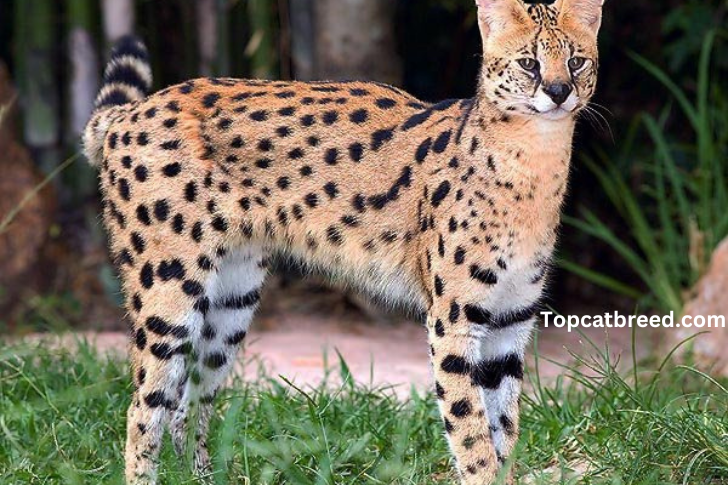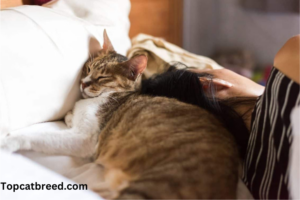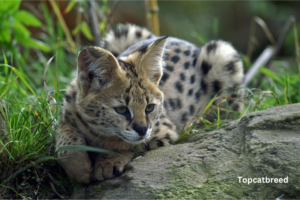Yes, it’s possible, but the outcome can vary widely depending on numerous factors. The question of whether can a serval cat kill a dog has raised concerns among pet owners and wildlife enthusiasts alike. Serval cats are medium-sized wild cats native to Africa, known for their agility and hunting skills. In some cases, a serval cat might be able to kill a dog, especially if the dog is small, untrained, or encounters the serval in its natural habitat. However, these confrontations are relatively rare.
The likelihood of a serval cat killing a dog increases when it feels threatened or cornered. Domestic dogs, on the other hand, come in various breeds and sizes, and a larger, more powerful dog is less likely to fall victim to a serval’s attack. Navigating the interactions between serval cats and dogs is a nuanced task. While it is theoretically possible for a serval cat to pose a threat to a dog, the likelihood of such encounters leading to harm varies.
Responsible pet owners should be vigilant, keeping dogs on leashes and avoiding areas where serval cats may be present. Understanding the dynamics between these species is essential for ensuring the safety of both pets and wildlife. The question of “can a serval cat kill a dog” underscores the importance of awareness and precautionary measures in these situations.
Are Serval Cats Dangerous for Dogs and Why?
Serval cats, though not typically a direct threat to dogs, can potentially pose dangers under specific circumstances. To understand these risks and why they may occur, it’s crucial to delve deeper into the dynamics of serval cats and dogs interacting.
Serval cats are known for their distinctive hunting techniques and territorial instincts, both of which play a role in determining whether they can be a danger to dogs. Their territorial nature can influence their interactions with dogs.
Analyzing the various situations in which serval cats may become a danger to dogs sheds light on the factors that can trigger aggression. Dogs entering the natural habitat of serval cats are more likely to encounter defensive behavior, potentially leading to a threat. Smaller dogs are at a higher risk, as serval cats may perceive them as potential prey, while larger dogs are less likely to be targeted.
Moreover, dogs displaying provocation or aggressive behavior towards serval cats could prompt defensive responses. Serval cats cornered or feeling trapped may respond aggressively in self-defense, increasing the risk to dogs. Most encounters between serval cats and dogs do not result in harm, emphasizing the potential for peaceful coexistence. To ensure the safety of dogs and serval cats, using a leash while walking in areas inhabited by serval cats prevents dogs from straying into their territory. Being aware of regions where serval cats live and avoiding them, if possible, reduces potential risks. When visiting wildlife sanctuaries or places with captive serval cats, close supervision of dogs is essential to follow guidelines provide the facility. Well-trained and socialized dogs are less likely to exhibit aggressive behavior towards wildlife, reducing the risk of confrontations.
Also Read. TOP 8 MOST AGGRESSIVE CAT BREEDS IN THE WORLD
What is a Serval Cat?
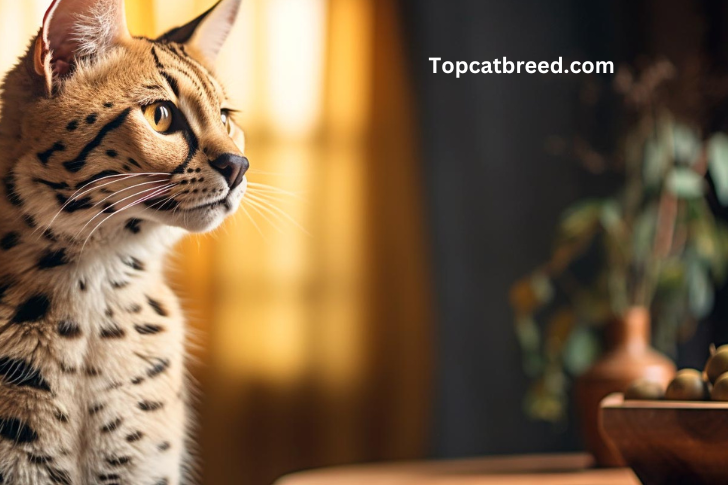
Serval cats, scientifically known as Leptailurus serval, are captivating wild felines native to Africa. To comprehend the potential threat a serval cat poses to dogs, we need to delve into their characteristics, behaviors, and the circumstances that can lead to encounters between the two species.
Size, Weight, and Physical Characteristics of Serval Cat
Understanding the physical attributes of serval cats is crucial for assessing their potential danger to dogs.
Serval cats are medium-sized wild felines, ranging from 20 to 24 inches in shoulder height and weighing between 20 to 40 pounds. Renowned for their agility and hunting prowess, these cats possess long legs, enabling them to leap through the air with precision when pouncing on their prey.
In their natural habitat, their characteristic golden-yellow coat is decorated with black dots and stripes, offering effective conceal men
Large, independently rotating ears allow them to locate sounds accurately. Serval cats also have a relatively short tail marked with a few black bands and a black tip.
History and Habitat
Serval cats boast a rich history in Africa, thriving in diverse environments like grasslands, savannas, and marshes. Their remarkable adaptability allows them to inhabit a wide range of habitats, making their geographic distribution extensive—from the far north to the far south of the continent.
Lifespan
In the wild, serval cats usually have a lifespan of 10 to 12 years. However, when kept in captivity under proper care, with ample nutrition and protection, they can thrive for 20 years or even more..
Understanding the Danger
The potential threat a serval cat may pose to a dog depends on various factors, including their behavior, territorial instincts, and the specific circumstances of their interaction. Serval cats are solitary hunters, known for their exceptional hunting skills. However, not all predatory behavior necessarily means they will attack dogs.
Serval cats can be territorial, and they may exhibit aggressive behavior when feeling threatened or when protecting their territory. This territorial behavior can vary between individual serval cats.
ALSO READ. Can a serval cat kill a human?_ TopCatBreed
Physical capabilities of serval cat
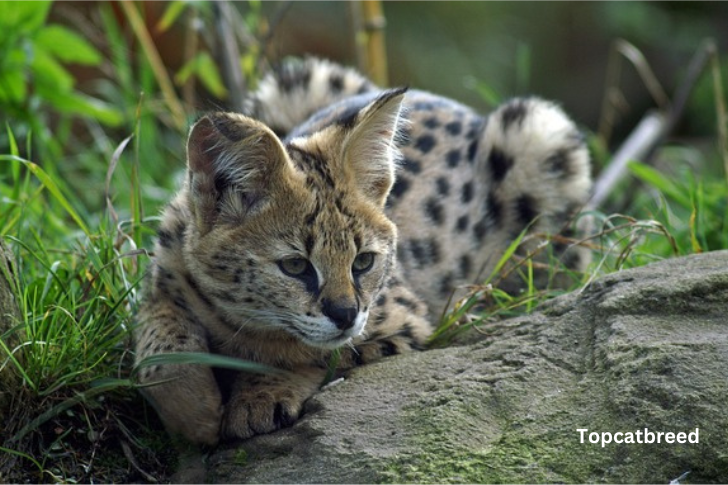
The physical capabilities of the serval cat are nothing short of remarkable, finely tuned for its life in the African grasslands and savannas. Their agility is perhaps the most striking feature. Serval cats possess long, lean legs that allow them to execute high leaps, sometimes reaching up to ten feet in the air. These impressive vertical jumps enable them to pounce on their prey with precision, making them exceptional hunters.
Serval cats, native to the African grasslands and savannas, are truly remarkable creatures with a set of physical capabilities that set them apart in the animal kingdom. These attributes make them formidable hunters and agile predators, finely adapted to their natural environment. Let’s take a closer look at these characteristics.
SUPER JUMPERS
One of the most striking features of serval cats is their agility, driven by their long and slender legs. These cats are renowned for their exceptional leaping abilities, capable of jumping to impressive heights. In the wild, servals can leap up to ten feet into the air. This agility allows them to spring onto unsuspecting prey, making them highly efficient hunters.
Camouflaged Coats
Serval cats possess distinctive golden-yellow fur covered with an intricate pattern of black spots and stripes. This unique coat serves a dual purpose in their natural habitat. Firstly, it provides effective camouflage, allowing them to blend seamlessly with the grasses and underbrush. This camouflage is essential for stalking and ambushing prey, making them nearly invisible until they decide to strike.
VISION
Serval’s have exceptional night vision, much like most cats do. They can hunt well at dawn, dusk, and night thanks to their big, oval eyes, which are well-suited for low light levels whether they are domestic cats or serval’s, a feral species.
Highly Sensitive Ears
Serval cats are equipped with large and expressive ears, a feature that further enhances their hunting abilities. What sets their ears apart is their ability to rotate independently, akin to radar dishes. This remarkable feature enables them to detect even the faintest rustle of prey or potential threats. Servals rely heavily on their sense of hearing when hunting, and their acute auditory senses make them formidable predators.
Climbing Prowess
Despite their medium size, serval cats are adept climbers. This skill enables them to navigate the varied landscapes of their African habitats, including grasslands, wetlands, and even more densely forested areas. Climbing allows them to gain advantageous positions for hunting, surveillance, or escape from potential threats. Can a serval cat kill a dog.
When a Serval Cat May Pose a Threat to a Dog:
Analyzing the various situations in which serval cats may become a danger to dogs sheds light on the factors that can trigger aggression.
In the Wild: Dogs entering the natural habitat of serval cats are more likely to encounter defensive behavior, potentially leading to a threat.
Captive Serval Cats: the behavior of serval cats in captivity is essential, as they may not view dogs as threats when accustomed to their presence.
Dog Size Matters: Smaller dogs are at a higher risk, as serval cats may perceive them as potential prey, while larger dogs are less likely to be targeted.
Provocation and Aggression: Dogs displaying provocation or aggressive behavior towards serval cats could prompt defensive responses.
Feeling Trapped: Serval cats cornered or feeling trapped may respond aggressively in self-defense, increasing the risk to dogs.
Coexistence and Safety Measures: Most encounters between serval cats and dogs do not result in harm, emphasizing the potential for peaceful coexistence. To ensure the safety of dogs and serval cats:
Supervision in Captivity: When visiting wildlife sanctuaries or places with captive serval cats, close supervision of dogs is essential to follow guidelines provided by the facility.
Training and Socialization: Well-trained and socialized dogs are less likely to exhibit aggressive behavior towards wildlife, reducing the risk of confrontations.
Interaction between serval cats and dogs
Serval cats are little African wildcats, whereas dogs exist in different shapes and sizes. They may be wary at first, smelling and inspecting each other out. They sometimes run around and play together, like new buddies getting to know each other.
It’s important for their humans to watch and make sure they are safe and happy. Some serval cats and canines are excellent playmates, while others prefer to do their own thing. Every animal is unique, and it is critical to respect their emotions and boundaries. So, when several cats and dogs connect, it’s a one-of-a-kind and intriguing experience and it’s up to their human companions to make it a pleasant and enjoyable one.
Gradual Introduction
It’s critical to take things slowly when several cats and canines first meet. Allow them to become comfortable to each other’s presence from a safe distance. Maintain them on leashes or behind gates or obstacles so they can see and smell each other without coming into physical contact.. This gradual approach helps them feel less anxious and more comfortable as they start their interaction.
Monitor Body Language:
The body language of both serval cats and dogs can give you important clues about how they’re feeling. Pay attention to their tails, ears, and vocalizations. It’s a good indicator if their tails are wagging or their bodies are calm. Can a serval cat kill a dog “If their tails are puffed out, their ears are flat, or they are snarling or hissing, it indicates that they are stressed or uncomfortable. Keep an eye on their body language and intervene if things become uncomfortable.
Provide Separate Spaces:
Creating separate spaces is vital when serval cats and dogs are learning to coexist. Make sure each animal has their own safe haven where they can retreat if they need a break. Cats might prefer high perches or hideaways, while dogs might appreciate their own crate or a quiet room. This way, they can choose when to interact and when to have some alone time, reducing potential conflicts.
Avoid Forced Interactions:
Never force serval cats and dogs to interact. Respect their boundaries and preferences. It’s completely acceptable if they don’t want to be close to each other. Forcing them to be in close proximity might cause stress and even hostility. Allow them to approach each other at their own pace and under your supervision.. If they show interest in each other, reward them with treats and praise to encourage positive interactions.
FAQS
1-Can a serval cat kill a pit-bull?
A serval cat could potentially harm a pit-bull, but it’s unlikely to kill one due to the pit bull’s size and strength advantage.
2-Can a serval cat kill?
Yes, serval cats are skilled hunters and can kill small prey in the wild.
3-Is a serval cat aggressive?
Serval cats are not naturally violent, although they can be territorial and aggressive if they feel threatened or trapped.. Proper socialization and care can help manage their behavior.
4-Can serval cats be kept as pets?
Serval cats are not recommended as pets in most places due to their wild nature and specific care requirements. They are typically better suited for wildlife sanctuaries or facilities.
5-Do serval cats make good companions for other domestic pets?
Serval cats may not be ideal companions for other domestic pets like dogs and cats. Their wild instincts and territorial behavior can pose challenges when trying to integrate them into a household with other animals.
conclusion
“In conclusion, serval cats, though captivating, have specific needs. Not normally aggressive, their wild nature raises concerns about keeping them as pets. When considering a serval cat, prioritize their well-being and understand the responsibilities and challenges. Can a serval cat kill a dog remains a consideration.

